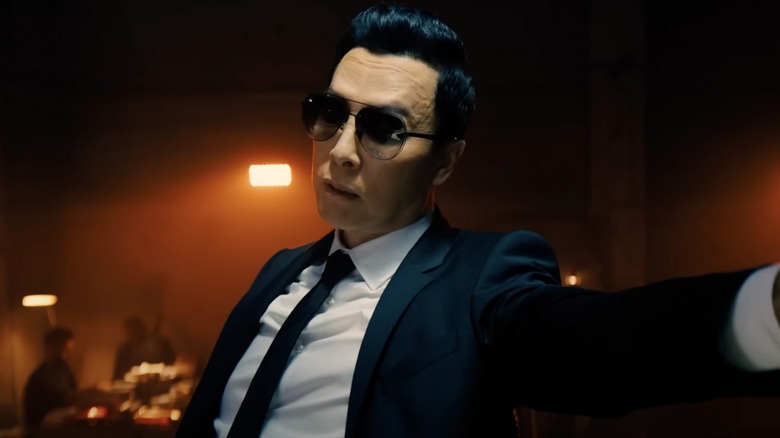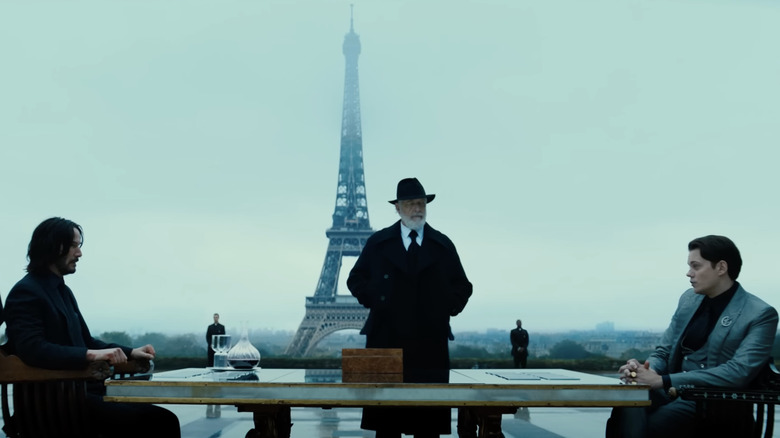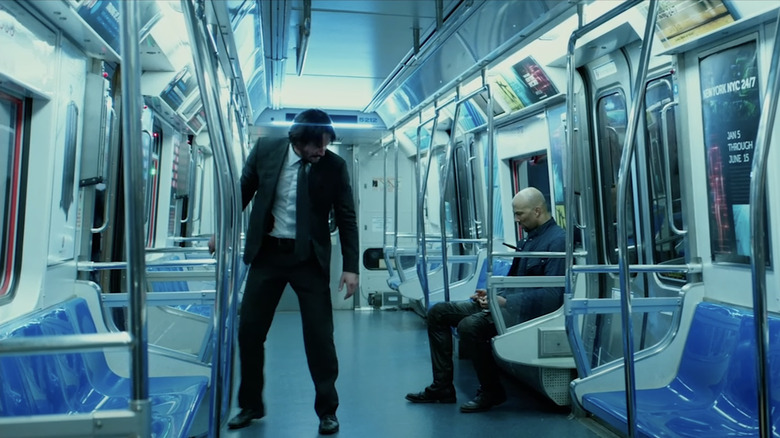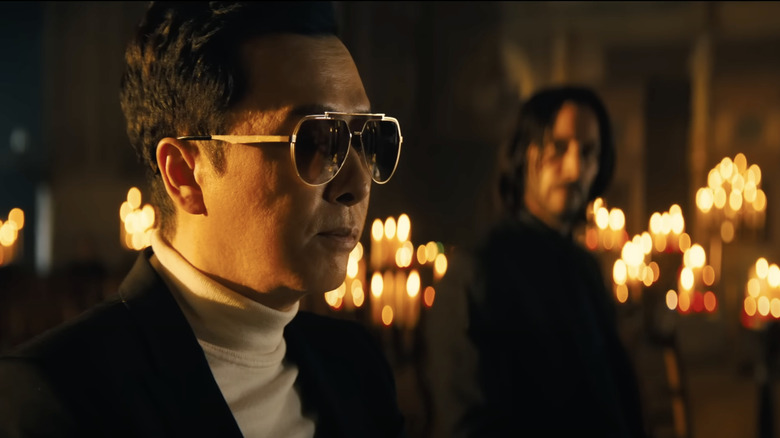John Wick: Chapter 4 Solves The Series' Antagonist Problem
Contains spoilers for "John Wick: Chapter 4"
"John Wick" is a rarity in the modern film franchise landscape. Since the first film debuted in 2014, audiences have witnessed not only its indelible impact on action movies but also its ability to outpace its peers in terms of escalating quality. In a volatile market where cinematic universes can be conceived and destroyed in the span of one film and long-running series struggle to keep their proven formulas fresh, the fact that each "John Wick" film is consistently better than the last is nothing short of astounding.
Of course, this is due in large part to the fine wine that is Keanu Reeves and the groundbreaking stunts from the mind of director Chad Stahelski. While their partnership is undeniably the linchpin of this universe, however, it is equally undeniable that the universe itself is what keeps fans engaged to this extent: the complex, mysterious hidden underworlds within underworlds; the tense and ever unfolding class system; and perhaps most of all, the reliably memorable characters. That being said, memorable doesn't always equal compelling.
Every character in the "John Wick" universe — from Baba Yaga himself to the policeman who patrols his neighborhood — is written with their own unique quirks and history. Yet until now, John's most dangerous foes have felt somewhat flat in comparison to the rest of the cast. With "John Wick: Chapter 4," however, Stahelski and writers Shay Hatten and Michael Finch have worked together to create a character web that's finally as emotionally cathartic as the series' action.
John Wick characters are usually well written but occasionally misused
To be clear, this isn't all to say that previous films haven't successfully introduced characters just as — if not more — compelling than the supporting cast of "Chapter 4." Rather, it's how the scripts use these characters that makes a difference.
Obviously, Winston (Ian McShane), Charon (Lance Reddick), and the Bowery King (Laurence Fishburne) are perfectly well performed and emotionally investible, each with their own meaningful impact on the series' story. It's the superb ability of "John Wick" to meld climactic resolution with intricate action sequences that unfortunately renders these players narratively inert once the bullets start flying.
In a story where problems are solved with fists and weapons, the most important characters are often those who can fight. When a writer imbues these combatants with complex motivations, stakes, and conflicting values, fight scenes become elegantly dynamic contests of both might and ideas and action films go from passable to transcendent. While this ideal combination of drama, character, and choreography is on full display throughout the "John Wick" saga, it almost never comes at key moments.
The best John Wick characters usually bow out too early
In the first three "John Wick" movies, there is a curious separation between the final contest of ideas and the final contest of skill. The death of weary sniper Marcus (Willem Dafoe), who attempts to maintain his relationships with both John and Viggo Tarasov (Michael Nyqvist), is a tragic referendum on one of the series' central ideas of balancing commitments to two conflicting worlds. The emotional fallout of bodyguard Cassian's (Common) failure to protect his ward from John gives their subway shootout the narrative weight of a final battle. Even Sofia (Halle Berry) parts ways with John once her debt to him has been fulfilled.
Despite these fighters having deep connections to John and the story, they are all absent during their respective film's final act. Instead, John's ultimate battles are against foes like Ares (Ruby Rose) in "John Wick: Chapter 2" and Zero (Mark Dacascos) in "John Wick: Chapter 3 – Parabellum." While their duels make for suitably impressive fight scenes, they lack the narrative backing to make them any more than visually stunning obstacles to overcome rather than emotionally cathartic climaxes.
On the one hand, this does somewhat focus the climax on quieter moments involving non-fighter characters, like John's execution of Santino D'Antonio (Riccardo Scamarcio) in "Chapter 2" or Winston's betrayal of John at the end of "Chapter 3." In a series defined by its unmatchable action style, however, it just seems like a missed opportunity not to synthesize combat and climax. This theory is arguably proved by how well "Chapter 4" pulls off just that.
Caine is the series' most effective antagonist yet
While "Chapter 4" has its own non-combative antagonist in Bill Skarsgård's impeccably dressed Marquis de Gramont, it's Donnie Yen's Caine who receives most of the focus. Like Cassian and Marcus before him, Caine embodies the contradictory commitments one has to make in this world. With each fight, the audience gets to see him wrestling with his debt to the High Table, his respect for his fellow assassins, and his desire to escape this life with his conscience at least somewhat intact.
Where Marcus, Cassian, and Sofia only get one moment to shine, however, "Chapter 4" brings Caine into focus every chance it gets. From his beautifully operatic duel with Koji Shimazu (Hiroyuki Sanada) in Osaka to the Sisyphean climb toward the Sacré-Cœur in Paris, Caine is a persistent, emotionally conflicting presence who keeps the audience engaged in both the combat and the drama.
The masterstroke of "Chapter 4" occurs in one of many scenes that make this the best film in the series. Stahelski and co. convincingly reunite John and Caine as a team on the steps toward the Sacré-Cœur only to realistically justify their ultimate standoff moments later. It's the sort of dynamic storytelling that comes from a consistent commitment to simple but relatable motivations.
Additionally, by keeping Caine present throughout the film, the final act is more satisfying and cohesive than those seen in the previous entries. In this way, "John Wick: Chapter 4" is a clear sign that the creative team behind this series is hungry to up its game with the pen as much as the sword.



